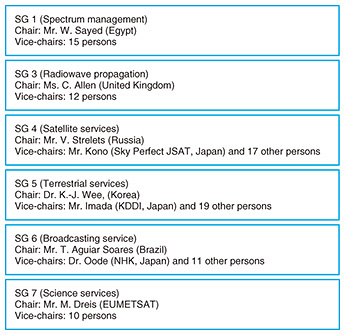 |
|||||||||||||||||||
|
|
|||||||||||||||||||
|
Global Standardization Activities Vol. 22, No. 7, pp. 53–60, July 2024. https://doi.org/10.53829/ntr202407gls ITU World Radiocommunication Conference 2023 (WRC-23)AbstractSince radio waves used in radio communications travel across national borders, international rules are required. Therefore, the International Telecommunication Union (ITU), the United Nations’ organization specialized in telecommunications, set forth the Radio Regulations (RR), which provides international rules for radio waves in each frequency and in each region of the world. The RR is reviewed and revised about every four years, and the international conference held for this purpose is the ITU World Radiocommunication Conference (WRC). Since the revised RR will be reflected in the regulations of Japan, the WRC is an extremely important meeting for the NTT Group, which provides mobile phones and other wireless services. This article reports on the ITU WRC 2023 (WRC-23) held in Dubai, United Arab Emirates, from November 20 to December 15, 2023. Keywords: ITU-R, World Radiocommunication Conference, Radio Regulations 1. ITU World Radiocommunication Conference 2023 (WRC-23)The World Radiocommunication Conference (WRC) is the largest conference in the International Telecommunication Union (ITU) to discuss updating the Radio Regulations (RR), which provides international rules and regulations for allocation of the spectrum to radio services, use of satellite orbits, and administrative and operational procedures for radio stations. The WRC is usually held every three to four years [1] and the last WRC, the ITU WRC 2023 (WRC-23), was held in Dubai, United Arab Emirates, from November 20 to December 15 (Fig. 1). Approximately 3900 participants from 163 Member States attended the WRC-23 and discussed agenda items for revision of the RR, as shown in Table 1. About 130 delegates from Japan, including the Ministry of Internal Affairs and Communications, other government agencies, and private companies attended the WRC-23, as well as NTT and NTT DOCOMO from the NTT Group.
In the RR, the world is divided into three regions, as shown in Fig. 2, and frequencies are allocated to services all over the world or in each region. In some cases, frequencies are allocated to services only for specific countries. As also shown in Fig. 2, there are four regional telecommunication organizations in Region 1, one in Region 2, and one in Region 3. Each regional telecommunication organization conducts activities for preparation work on WRC. Japan is a member of the Asia-Pacific Telecommunity (APT) in Region 3 and is also active in the APT Conference Preparatory Group for WRC (APG), which develops common proposals for WRC from APT.
Figure 3 shows the structure of WRC-23. There are seven committees (COMs 1–7) under the Plenary. Discussions to revise the RR were mainly made in COM 4 for terrestrial/maritime/aeronautical issues, COM 5 for satellite issues, and COM 6 for general issues and agenda items for future WRCs. Dr. Hiroyuki Atarashi (NTT DOCOMO) from Japan was appointed as the chair of COM 4, which addresses terrestrial issues, including identifications of frequencies for International Mobile Telecommunication (IMT)*1 such as fifth-generation mobile communication systems (5G) and Beyond 5G (agenda item 1.2) and considerations on the use of high-altitude platform stations (HAPS)*2 as IMT base stations (HIBS) for the implementation of non-terrestrial networks (NTN) (agenda item 1.4).
1.1 Identification of frequencies for IMT (agenda item 1.2)Regarding the additional identification of frequencies for IMT such as 5G and Beyond 5G, discussions were held on the frequency range of 6425–7025 MHz (Although the scope of this agenda item is only for Region 1, this agenda item relates to Japan in Region 3 and the details are described later in this article) and the frequency range of 7025–7125 MHz (worldwide). Japan supported the identification of the frequency range of 7025–7125 MHz for IMT based on the studies conducted by the ITU Radiocommunication Sector (ITU-R) and supported the identification of the frequency range of 6425–7025 MHz for IMT in Region 1 because of the benefit of economies of scale. Although identification of the frequency range of 6425–7025 MHz for IMT in Region 3 is out of the scope of this agenda item, proposals were made for identification of this frequency range for IMT in 6 countries in Region 3, including China, and countries in Region 2. From the view of the harmful interference to existing radio systems, such as satellite systems, that are operated in the same frequency band, discussions were held with respect to the limit on equivalent isotropic radiated power applied to IMT base stations. After discussion, consensus was finally reached, and the identification of the frequency range of 7025–7125 MHz for IMT was agreed to in all of Region 1, some countries in Region 2 (Brazil and Mexico), and all of Region 3. Regarding the proposal of identifying the frequency range of 6425–7025 MHz for IMT in some counties of Region 3, considering the interference to neighbouring countries, identification of this frequency range to only a few countries (Cambodia, Laos, and Maldives), excluding China, was agreed. Identification of the frequency range of 6425–7025 MHz for IMT was also agreed in all of Region 1 and in some countries in Region 2 (Brazil and Mexico). 1.2 Consideration of the use of HIBS (agenda item 1.4)In Beyond 5G, a space radio access network (RAN) and NTN are expected to be implemented, which will enable the expansion of coverage in mountainous areas and at sea and the quick restoration of communication networks in the event of a large-scale disaster. HIBS is one candidate to implement a space RAN and NTN [2]. At the previous WRC (WRC-19), Japan proposed and led discussions to include the consideration of HIBS in the WRC-23 agenda item, and at WRC-23, discussions were held on the addition of new frequency bands (694–960, 1710–1885, 2500–2690 MHz) and a review to relax conditions for the use of existing available frequency bands (1885–1980, 2010–2025, 2110–2170 MHz) for use of communications between HIBS and terminals. As a result of the discussions, the addition of new frequency bands other than 694–960 MHz and the relaxation of conditions in the existing available frequency bands were agreed. Regarding the 694–960-MHz band, there were many discussions with China, Russia, Vietnam, and Iran, who were concerned about interference to existing systems. Finally, it was agreed to use this frequency band for HIBS in Regions 1 and 2. In Region 3, it was also agreed to use the entire frequency band or portions of this frequency band for HIBS in 14 countries, including Japan and countries where HIBS is expected to be deployed*3. 1.3 Other agenda items (agenda items relating to science and satellite issues)Other topics relating to science and satellites issues were also discussed. In agenda item 1.13, consideration was made to upgrade the status of space research (satellite-to-satellite, satellite-to-Earth station) in the frequency range of 14.8–15.35 GHz from secondary service to primary service*4, and it was agreed to upgrade the status to primary service in principle. However, it was also agreed to apply a power flux density (pfd) limit at the surface of the Earth to radio waves transmitted from a satellite for satellite-to-satellite link and to keep a secondary basis between a satellite and an Earth station with respect to the protection of terrestrial services in several countries including Japan. Agenda item 1.16 relates to non-geostationary orbit satellites, which have been increasingly used. In this agenda item, it was discussed to enable communications with the Earth stations on ships and aircraft in the frequency ranges of 17.7–18.6, 18.8–19.3, 19.7–20.2, 27.5–29.1, and 29.5–30 GHz. Finally, it was agreed to make the communications available in those frequency bands and to establish conditions so that such communications would not adversely affect terrestrial radio systems, including 5G and private 5G systems in the 28-GHz-frequency band. 1.4 Agenda items for WRC-27During the WRC-23, the agenda items for future WRCs were also discussed, and the agenda items shown in Table 2 were decided as the agenda items for the WRC-27.
Regarding additional identification of frequencies for IMT, discussions were held mainly on the frequency range so-called Frequency Range 3 (FR3) or mid-band, particularly the frequency range of 7–15 GHz. After discussion, the frequency ranges of 7125–8400-MHz and 14.8–15.35-GHz bands were agreed as candidates. The frequency range of 4400–4800 MHz was also decided as a candidate, a certain range of which is already used for IMT in Japan. To implement NTN, direct-to-handset satellite communications are very attractive, which provide direct communications between mobile terminals such as smartphones and low-Earth orbit satellites. For the agenda item for WRC-27, frequency bands for this type of communications were discussed on the basis of proposals from Japan and other countries, and it was decided that the frequency range of 694 MHz–2.7 GHz would be a candidate for discussion at WRC-27.
2. ITU Radiocommunication Assembly 2023 (RA-23)Preceding WRC-23, the ITU Radiocommunication Assembly 2023 (RA-23) was held from November 13 to 17, 2023 at the same venue as the WRC-23. The RA is the general meeting of the ITU-R and approves ITU-R Recommendations, ITU-R Questions, and ITU-R Resolutions, which provide the working method of ITU-R and appoints the chairs and vice-chairs of ITU-R Study Groups (SGs). The RA-23 approved Resolution ITU-R 56-3, which defines the name of the so-called “6G” as IMT-2030 [3]. The RA-23 also approved Recommendation ITU-R M.2160, which provides a framework and overall objectives of the future development of IMT for 2030 and beyond [4]. With these documents, it is expected to accelerate studies relating to 6G in ITU-R. As shown in Fig. 4, the chairs and vice-chairs of each SG were appointed, and all three candidates nominated by Japan were approved as candidates for vice-chairs of SG 4, SG 5, and SG 6. Regarding the structure and scope of the SGs, inter-satellite service is explicitly included in the scope of SG 4 [5].
During the RA-23, the maximum number of terms for Working Party (WP) chairs was discussed. It was agreed that the maximum number of terms is 2 (1 term corresponds to approximately 4 years), extendable to 3 if circumstances necessitate. Other ITU-R Resolutions, Recommendations, and Questions were also approved and will serve as guidelines for future ITU-R activities. 3. Future plansTowards WRC-27, the NTT Group will continue to actively participate in and contribute to ITU-R meetings, preparatory meetings in the Asia-Pacific region such as APG, and relevant meetings in Japan. References
|
|||||||||||||||||||










